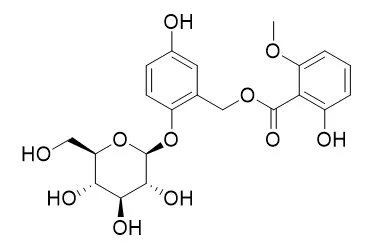Six phenolic compounds isolated from Curculigo orchioides, including 2,6-dimethoxy benzoic acid (1), curculigoside A (2), Curculigoside B (3), curculigine A (4), curculigine D (5) and 3,3',5,5'-tetramethoxy-7,9':7',9-diepoxylignan-4,4'-di-O-beta-D-glucopyranoside (6), together with the ethanol extract of Curculigo orchioides were evaluated for their activity on osteoblasts in neonatal rat calvaria cultures and multinucleated osteoclasts derived from rat marrow cells so as to characterize the antiosteoporotic components of this plant and explore the relationship of chemical structure with antiosteoporotic activity.
METHODS AND RESULTS:
The proliferation of osteoblast was assayed by MTT methods. The activity of ALP (alkaline phosphatase) and TRAP (tartrate-resistant acid phosphatase) was measured by p-nitrophenyl sodium phosphate assay. The TRAP stain was used to identify osteoclast in morphology. The resorption pit area on the bone slices formed by osteoclast was measured by computer image processing. The ethanol extract exhibited stimulatory effect on both the osteoblast proliferation and the ALP activity. Six compounds all increased the osteoblast proliferation, and compounds (1), (2) and (4) also slightly increased the osteoblastic ALP activity. Compounds (1), (2), (3), (6) and the ethanol extract decreased area of bone resorption pit, osteoclastic formation and TRAP activity.
CONCLUSIONS:
These results indicated that phenolic compounds are antiosteoporotic chemical constituents from Curculigo orchioides, and their activities are related with chemical structures. |






 Cell. 2018 Jan 11;172(1-2):249-261.e12. doi: 10.1016/j.cell.2017.12.019.IF=36.216(2019)
Cell. 2018 Jan 11;172(1-2):249-261.e12. doi: 10.1016/j.cell.2017.12.019.IF=36.216(2019) Cell Metab. 2020 Mar 3;31(3):534-548.e5. doi: 10.1016/j.cmet.2020.01.002.IF=22.415(2019)
Cell Metab. 2020 Mar 3;31(3):534-548.e5. doi: 10.1016/j.cmet.2020.01.002.IF=22.415(2019) Mol Cell. 2017 Nov 16;68(4):673-685.e6. doi: 10.1016/j.molcel.2017.10.022.IF=14.548(2019)
Mol Cell. 2017 Nov 16;68(4):673-685.e6. doi: 10.1016/j.molcel.2017.10.022.IF=14.548(2019)